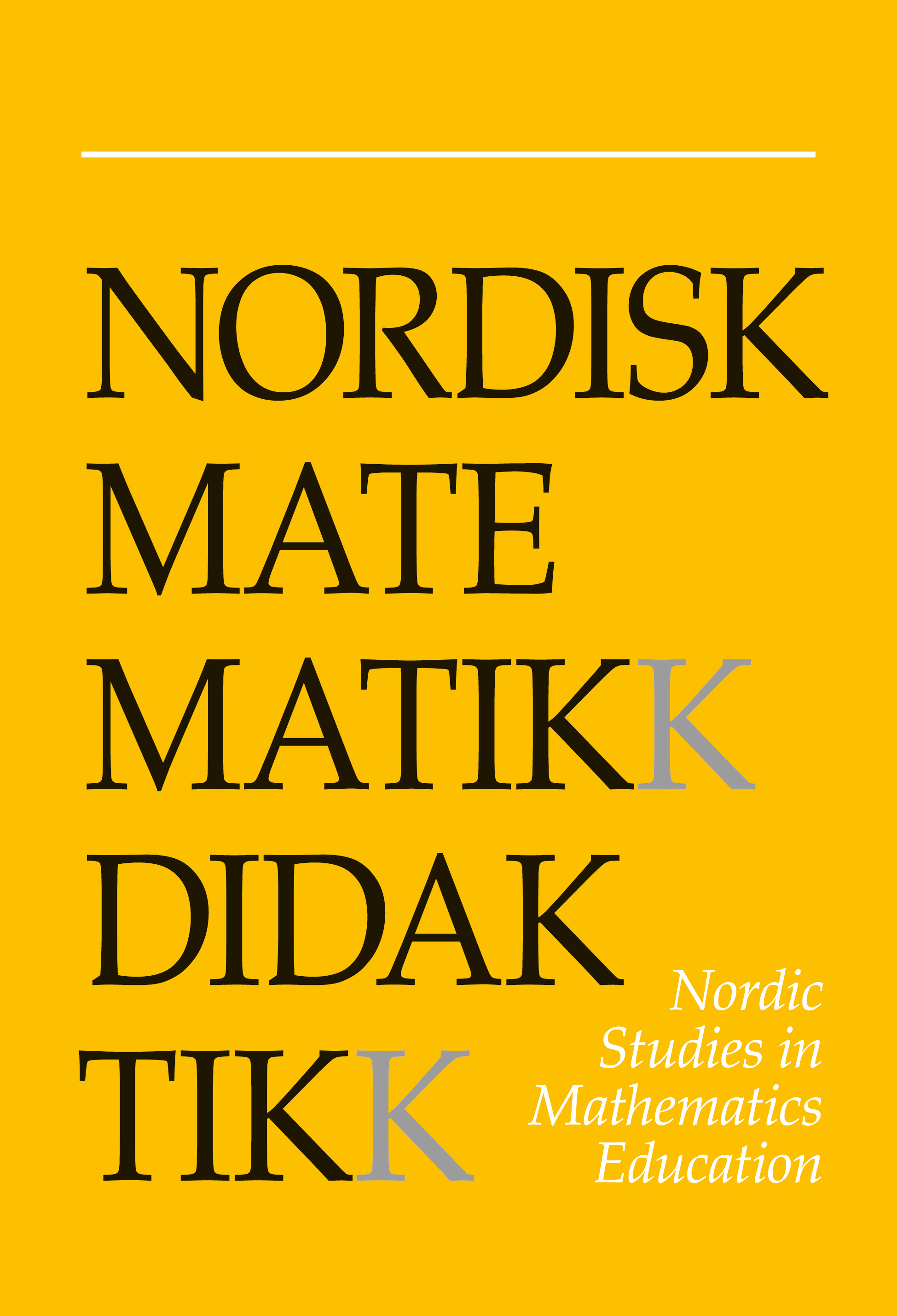Students’ strategies of expanding fractions to a common denominator – a semiotic perspective
DOI:
https://doi.org/10.7146/nomad.v19i2.148632Abstract
The aim of this article is to identify students’ strategies while solving tasks which involve the expansion of fractions to a common denominator. In this case study we follow two groups of 11 year old students and their use of the artefact multilink cubes in the solution process. The analysis of the students’ strategies is based upon a semiotic-cultural framework. Five different types of strategies are reported: trial-and-error, factual, contextual, embodied-symbolic and symbolic. The concept of semiotic contraction is also used in the analysis.
References
Arzarello, F. & Robutti, O. (2008). Framing the embodied mind approach within a multimodal paradigm. In L. D. English (Ed.), Handbook of international research in mathematics education (pp. 716-745). London: Routledge.
Bryman, A. (2008). Social research methods. Oxford University Press.
Gallese, V. & Lakoff, G. (2005). The brains' concepts: the role of the sensory-motor system in conceptual knowledge. Cognitive neuropsychology, 21, 1-25.
Koukkoufis, A. & Williams, J. (2006). Semiotic objectifications of the compensation strategy: en route to the reification of integers. RELIME. Revista latinoamericana de investigación en matemática educativa, 9 (1), 157-176.
LaCroix, L. N. (2012). Mathematics learning through the lenses of cultural historical activity theory and the theory of knowledge objectification. In M. Pytlak, T. Rowland & E. Swoboda (Eds.), Proceeding of CERME7 (pp. 2462- 2471). Rzeszów: ERME.
Lakoff, G. & Núñez, R. E. (2000). Where mathematics comes from: how the embodied mind brings mathematics into being. New York: Basic Books.
Linchevski, L. & Williams, J. (1999). Using intuition from everyday life in 'filling' the gap in children's extension of their number concept to include the negative numbers. Educational Studies in Mathematics, 39 (1), 131-147. https://doi.org/10.1023/A:1003726317920
Lorange, A., & Rinvold, R. A. (2014). Levels of objectification in students' strategies. In B. Ubuz, C. Haser & M. A. Mariotti (Eds.), Proceedings of CERME 8 (pp. 323-332). Antalya: ERME.
Núñez, R. (2012). On the science of embodied cognition in the 2010s: research questions, appropriate reductionism and testable explanations. Journal of the Learning Sciences, 21 (2), 324-336. https://doi.org/10.1080/10508406.2011.614325
Radford, L. (2002). The seen, the spoken and the written. A semiotic approach to the problem of objectification of mathematical knowledge. For the Learning of Mathematics, 22 (2), 14-23.
Radford, L. (2003). Gestures, speech, and the sprouting of signs: a semiotic-cultural approach to students' types of generalization. Mathematical Thinking and Learning, 5 (1), 37-70. https://doi.org/10.1207/S15327833MTL0501_02
Radford, L. (2006a). Algebraic thinking and the generalization of patterns: a semiotic perspective. In S. Alatorre, J. L. Cortina, M. Sáiz & A. Méndez (Eds.), Proceedings of the 28th conference of the International Group for the Psychology of Mathematics Education, North American Chapter (Vol. 1, pp. 2-21). Mérida: Universidad pedagógica nacional.
Radford, L. (2006b). Elements of a cultural theory of objectification. Revista latinoamericana de investigación en matemática educativa (special issue on semiotics, culture and mathematical thinking), 103-129.
Radford, L. (2008a). The ethics of being and knowing: towards a cultural theory of learning. In L. Radford, G. Schubring & F. Seeger (Eds.), Semiotics in mathematics education: epistemology, history, classroom, and culture (pp. 215-234). Rotterdam: Sense Publishers. https://doi.org/10.1163/9789087905972_013
Radford, L. (2008b). Iconicity and contraction: a semiotic investigation of forms of algebraic generalizations of patterns in different contexts. ZDM, 40 (1), 83-96. https://doi.org/10.1007/s11858-007-0061-0
Radford, L. (2010a). Layers of generality and types of generalization in pattern activities. PNA, 4 (2), 37-62. https://doi.org/10.30827/pna.v4i2.6169
Radford, L. (2010b). Signs, gestures, meanings: algebraic thinking from a cultural semiotic perspective. In V. Durand-Guerrier, S. Soury-Lavergne & F. Arzarello (Eds.), Proceedings of the sixth conference of european research in mathematics education (CERME 6) (pp. XXXIII-LIII). Lyon: Université Claude Bernard.
Schoenfeld, A. H. (2008). Research methods in (mathematics) education. In L. D. English (Ed.), Handbook of international research in mathematics education (second edition, pp. 467-519). New York: Routledge.
Wilson, M. (2002). Six views of embodied cognition. Psychonomic bulletin & review, 9 (4), 625-636. https://doi.org/10.3758/BF03196322
Downloads
Published
How to Cite
Issue
Section
License

This work is licensed under a Creative Commons Attribution-NonCommercial-ShareAlike 4.0 International License.



